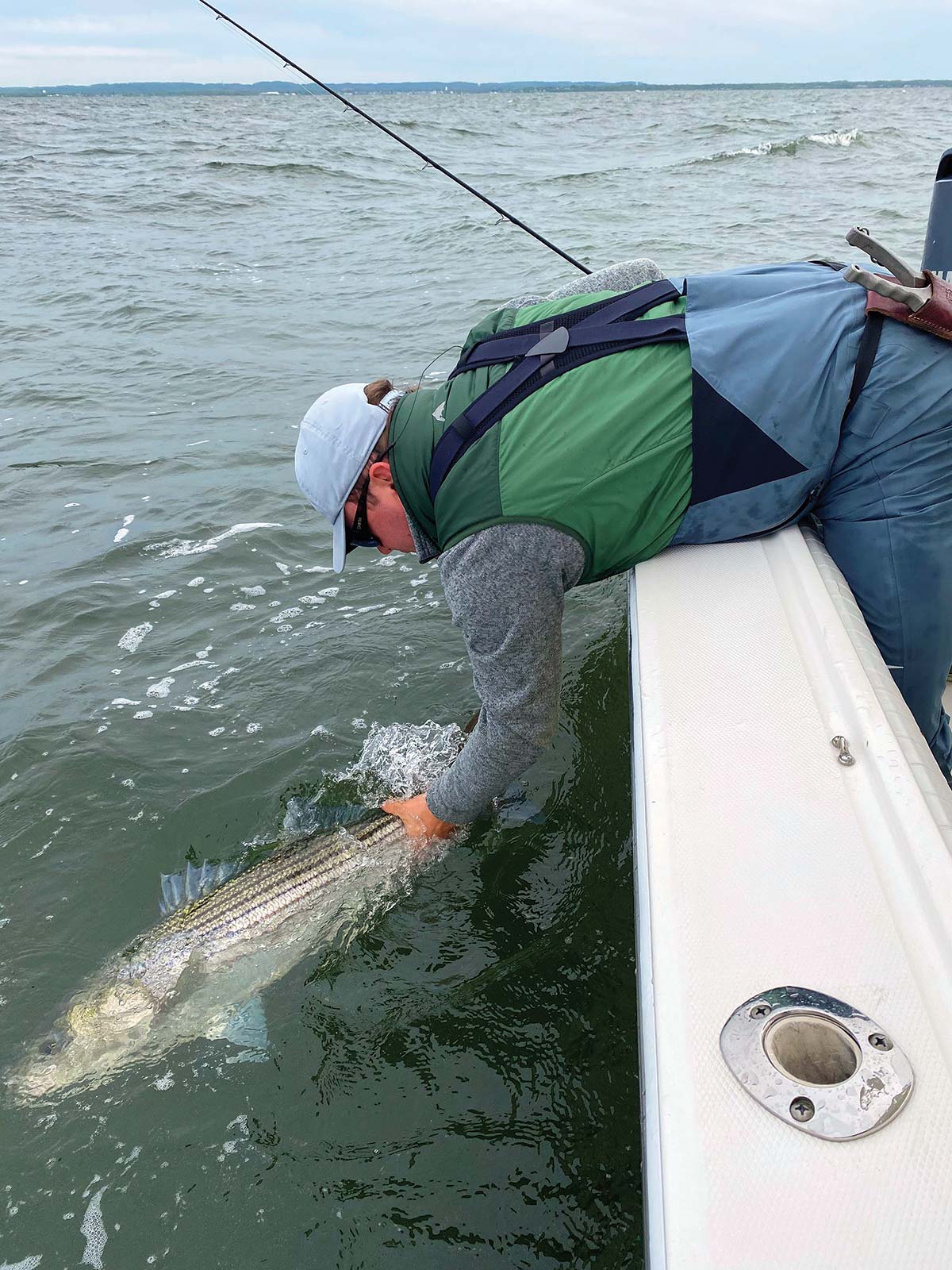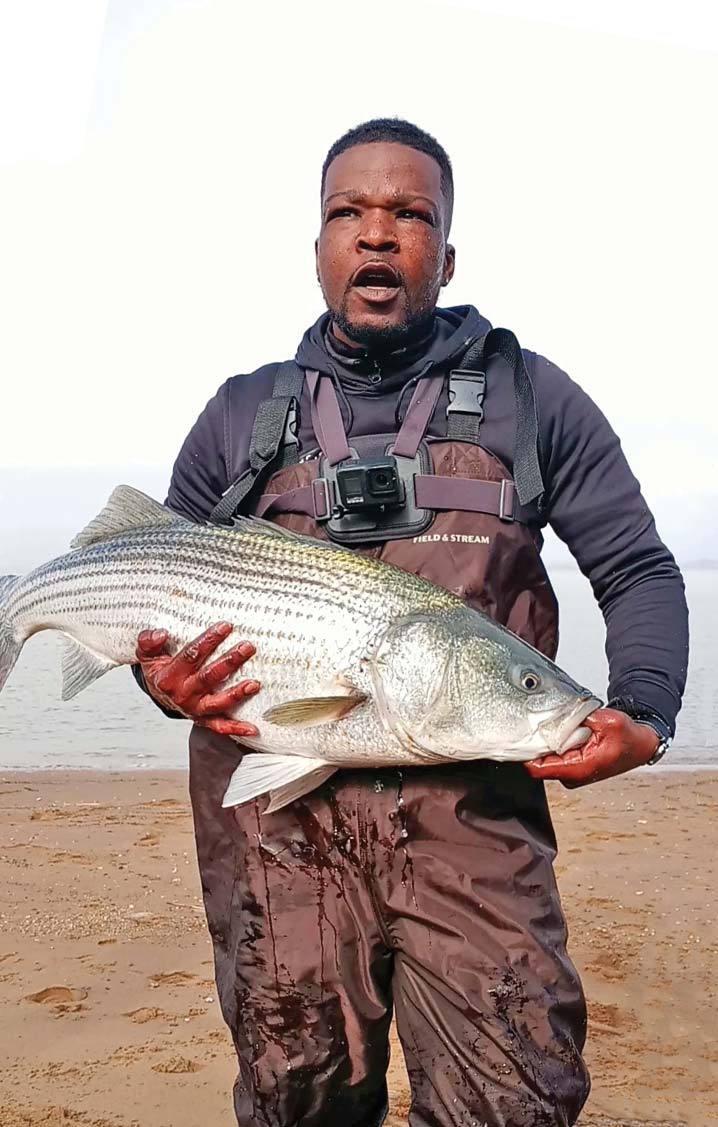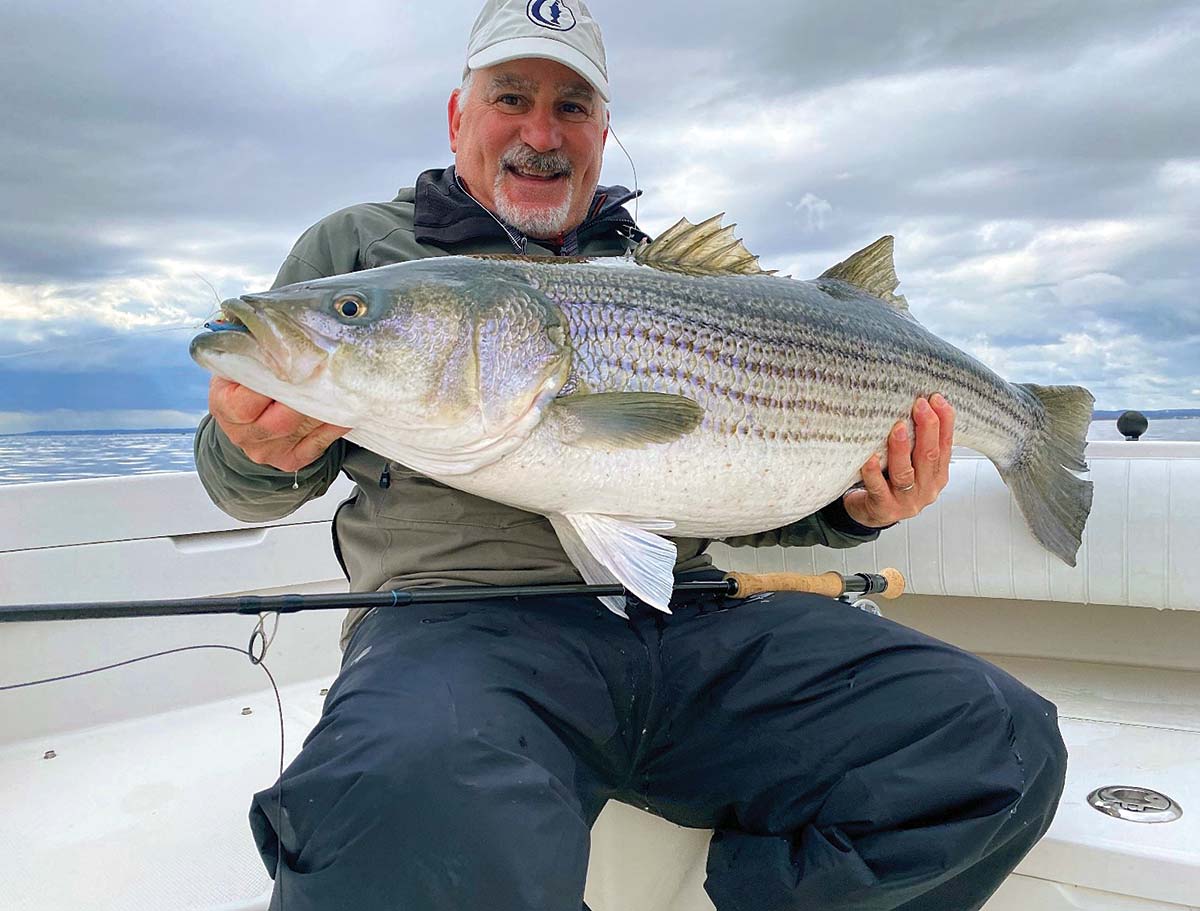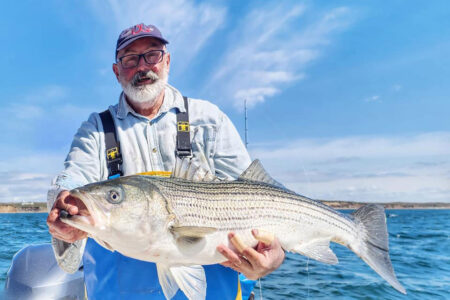
Putting release mortality rates on stripers into a scientific perspective.
Migratory populations of striped bass are managed by the Atlantic States Marine Fisheries Commission (ASMFC) under the Striped Bass Interstate Fisheries Management Plan. As part of the management process, ASMFC periodically conducts stock assessments in order to provide updated information on the health and status of commission managed fish stocks.
The results of their 2018 striped bass benchmark stock assessment indicated that the striped bass stock has been overfished since 2013 and is currently experiencing overfishing. After undergoing peer review by a panel of independent fisheries scientists, this assessment was accepted for management use requiring ASMFC to take action to address both overfishing (rate of removals of fish from the population) and the overfished status (female spawning stock biomass below the established threshold).
To begin to address overfishing, Addendum VI to Amendment 6 of the striped bass management plan was implemented in 2020. In terms of the recreational striped bass fishery, Addendum VI implemented a one fish bag limit and a slot possession limit for the ocean fishery to reduce total recreational removals. Amendment 6 also requires the use circle hooks when fishing with bait (defined by ASMFC as any marine or aquatic organism live or dead) in order to reduce potential mortality due to gut hooking.
As of 2022, ASMFC is developing a new amendment to the striped bass management plan – Amendment 7 – in order to “update the management program to better align with current fishery needs and priorities, and build upon the Addendum VI action to initiate rebuilding.”
One of the goals of Amendment 7 is to identify and implement additional measures that will reduce recreational release mortality, which ASMFC has determined constitutes a large component of annual striped bass fishing-related mortality.
According to ASMFC, recreational size restrictions and possession limits along with angler preferences has resulted in roughly 90% of the recreational striped bass catch being released over the past several decades. ASMFC uses a 9% mortality rate to estimate the number of striped bass that die as a consequence of being caught and released.
As noted in draft Amendment 7, this does not mean that every time a striper is released alive it has a 9% chance of dying. What it means is that overall, it is assumed that 9% of all striped bass released by recreational fishermen don’t survive.
The big question that most striped bass anglers have on their minds is , where does this 9% mortality rate estimate come from?
How 9% Came To Be
The Magnuson-Stevens Fishery Conservation and Management Act (MSA) states that conservation and management measures in fishery management plans “shall be based upon the best scientific information available.” However, while a number of studies estimating mortality rates associated with striped bass catch-and-release focused on hook types (j hooks vs. circle hooks) or mortality in freshwater systems have been published in scientific literature, studies estimating striped bass survival after being caught and released in marine waters are limited.
The 9% hooking mortality rate estimate comes from a study conducted by Dr. Paul Diodati of the Massachusetts Division of Marine Fisheries (DMF) and Dr. R. Anne Richards from NOAA’s Northeast Fisheries Center published in The Transactions of the American Fisheries Society in 1996. Their study, which was conducted in a high salinity saltwater impoundment, analyzed variables related to mortality of sub-legal-sized stripers (under 28 inches, the minimum size limit in place at the time) including hook type, hooking location, and angler experience.
Overall, predicted (i.e. modeled) and observed hooking mortality for their experimental group of fish was 9% with mortality attributed to some combination of angling induced stress and/or injury after the fish were caught and released.
It should be noted that Diodati and Richards acknowledged that there are limitations to using the results of their study to estimate coastwide hooking mortality of striped bass since their experimental design did not include a detailed assessment of the effects of factors such as fish size, variable environmental conditions encountered in the wild, and differing regional angling methods on mortality. However, according to ASMFC, an analysis of other striped bass release mortality studies by their Technical Committee has confirmed that “an overall 9% release mortality rate accounts for variations in conditions and factors that contribute to release mortality coastwide”. Therefore, the 9% mortality estimate for striped bass caught and released in saltwater is currently considered the best available scientific information by ASMFC and used in their recreational release mortality estimates.
Note that this may change in the future as a result of a new study using acoustic telemetry technology initiated in 2021 by DMF which hopefully will provide an updated and more robust striped bass catch-and-release mortality rate estimate.

A Cause For Stress
The NOAA Fisheries Marine Recreational Information Program (MRIP) compiles annual estimates of the number of striped bass caught and released by anglers coastwide. ASMFC applies the 9% mortality rate to the MRIP recreational release data to calculate the number of striped bass assumed to die after being caught and released. For example, in 2020 the MRIP data estimates that recreational anglers caught and released approximately 30.7 million stripers. Appling the 9% mortality rate to this number results in a catch-and-release mortality estimate of 2.76 million fish.
While managers and stakeholders debate what changes to the current management measures should be included in Amendment 7 to reduce mortality in the recreational striped bass fishery, utilizing catch-and-release best practices can ensure greater chances of survival of released stripers and contribute to the conservation and sustainability of this important species.
Catch-and-release can be an effective conservation practice; however, many people assume that all fish they release will survive the experience since they observe that the fish appear relatively unharmed and swim away. Unfortunately, the initial behavior of a released fish can be a poor indicator of whether it lives or dies and fish that appear to be healthy when released may succumb to injuries or stress caused by angling and handling some time after release potentially resulting in mortality.
Physiological stress begins to occur in fish due to ‘burst’ exercise when they are hooked and attempt to avoid capture. Then, if they struggle intensely for prolonged periods during angling they become exhausted. When angled to exhaustion, lactic acid builds up in their muscle tissue leading to a situation known as acidosis, which, in turn, leads to physiological imbalance, muscle failure, and in extreme cases mortality.
Environmental conditions can exacerbate the rate of stress during angling.
Air, Land & Water
Research has shown that stripers caught in freshwater portions of rivers or low salinity regions of estuaries are more likely to experience environmental stress and stress-induced mortality during catch-and-release than bass taken in high salinity waters. A number of studies have also documented that stress and stress-related mortality in striped bass caught and released is temperature dependent.
In general, as water temperatures rise above the striper’s optimum temperature range angler-induced stress increases along with increased potential for post release mortality. This is especially true when water temperatures reach or exceed 70 degrees and you are fishing in freshwater or low salinity waters.
Air temperature when striped bass are caught and released is also an important factor. This is particularly important if fish are removed from the water prior to release during hot weather or when substantial differences between water and air temperatures exist. In addition, if stripers are removed from the water prior to release, the duration of air exposure influences recovery time of released fish and can lead to sublethal effects like impaired swimming performance as well as mortality. Stress from air exposure is worse when a fish is exhausted, injured, or water temperatures are beyond their normal range.
Finally, recreational fishermen control many factors that can stress or injure striped bass that are caught and intended to be released. Aside from physical injury from hooking damage, the manner in which stripers are landed, handled, and released can cause additional injuries, increase stress, and contribute to post release mortality.
As anglers, it’s all about the choices we make. Adding proper catch-and-release techniques to your fishing arsenal will reduce stress, minimize injury, and increase the chances of survival of stripers that you release. This begins even before you hit the water by being aware of the current environmental conditions such as water temperature, air temperature, and salinity of your target fishing locale.

Employing Best C&R Practices
In addition to understanding the environmental conditions at the time of your catch, other recognized tactics which can help boost survival rates of released striped bass include:
- Using appropriate weight-class rods and reels with appropriately set drags that allow stripers to be landed quickly to reduce exhaustion and minimize stress.
- Switching treble hooks for single hooks to reduce hook damage and unhooking time.
- Using non-offset circle hooks when fishing with bait to reduce the chances of gut hooking.
- Crushing barbs on hooks or using barbless hooks to reduce damage at the hook site and aid in quick hook removal.
- Setting the hook quickly when you feel a strike to prevent the bass from taking the hook deep in its throat where it may cause damage or be hard to remove.
- Landing stripers quickly without playing them to exhaustion to reduce stress or injury.
- Avoiding the use of gaffs to land stripers that are going to be released.
- Using nets made of non-abrasive materials like soft knotless nylon or rubber to reduce removal of the stripers protective mucous.
- Making sure nets are of sufficient size so they don’t bend the bass severely.
- Limiting the use of lip grippers to situations when you have no other way to control or handle a striper.
- Handling and unhooking stripers quickly in or over the water whenever possible.
- Minimizing air exposure if a striper has to be removed from the water to unhook it; research suggests a target for time out of water is 10 seconds to prevent the onset of stress.
- Holding stripers horizontally with two hands gripping the area near the base of the tail and supporting their body near the pelvic fins as opposed to vertically which can cause stress and displace or injure internal organs.
- Eliminating contact with dry surfaces like sand or rocks and handling them with wet hands or wet gloves to minimize removal of their protective mucous.
- Avoiding touching the eyes, gills or gill rakers.
- Avoiding forcefully removing hooks or tearing tissue when removing hooks by backing hooks out through the original wound.
- Only using hook removal tools (pliers, hemostats) if it will help with quick hook removal for stripers hooked in the jaw or mouth.
- Cutting the leader close to the hook if a striper is deep hooked rather than trying to remove the hook with a hook removal device.
- Quickly and gently returning unstressed stripers to the water head first in an upright position and let them swim out of your grasp.
- Reviving exhausted or stressed stripers prior to release by supporting their weight and holding them headfirst into the current or moving them in a figure-eight pattern so water flows in the mouth and over the gills.
The ASMFC’s Atlantic Striped Bass Management Board (Board) is expected to consider public comment Draft Amendment 7 to the Atlantic Striped Bass Fishery Management Plan sometime this month. The public comment deadline was April 15, at which point the Board is expected to meet to review public comment and select final measures for the Amendment to be passed along to for final ASMFC approval. For more information visit ASMFC.org.




